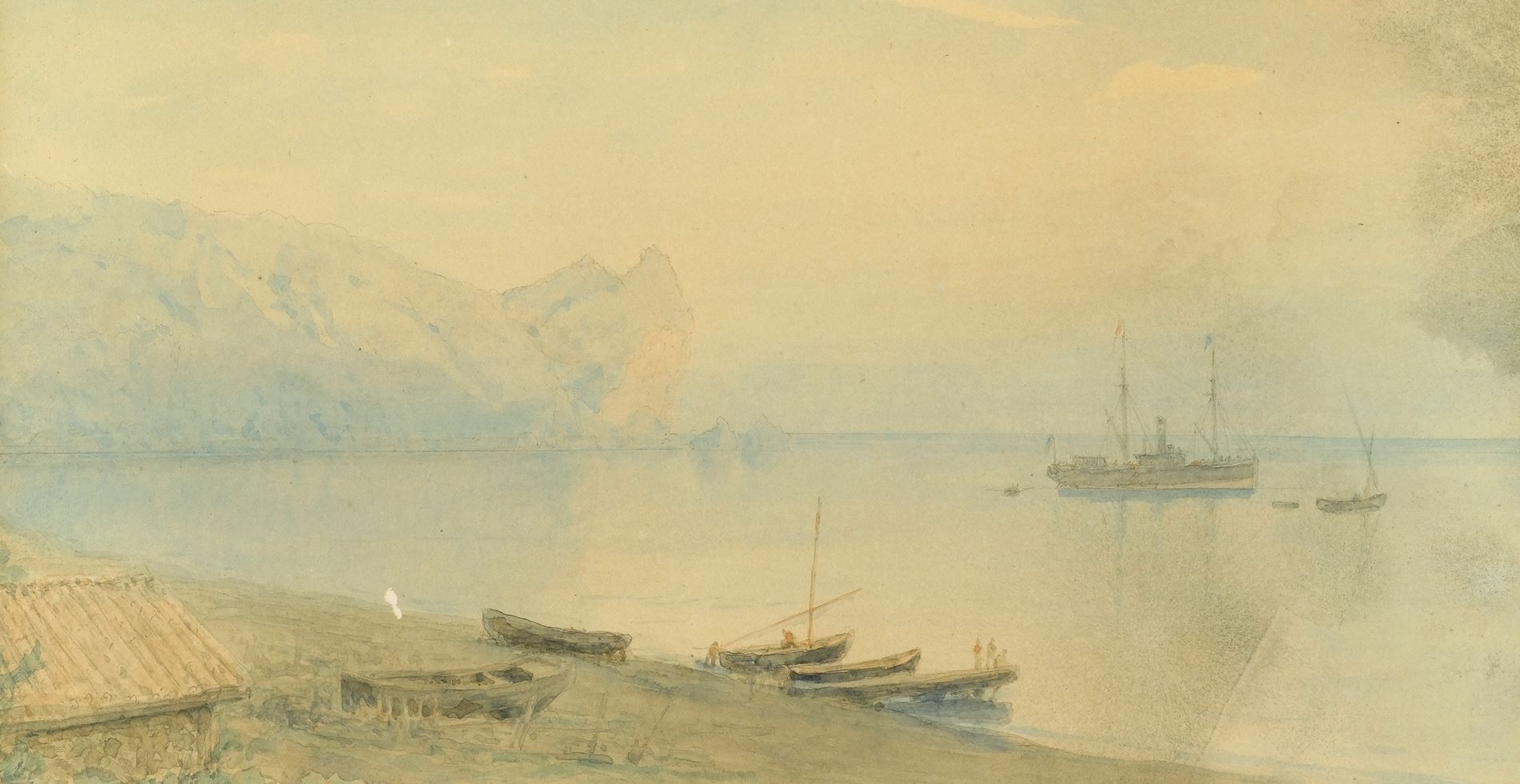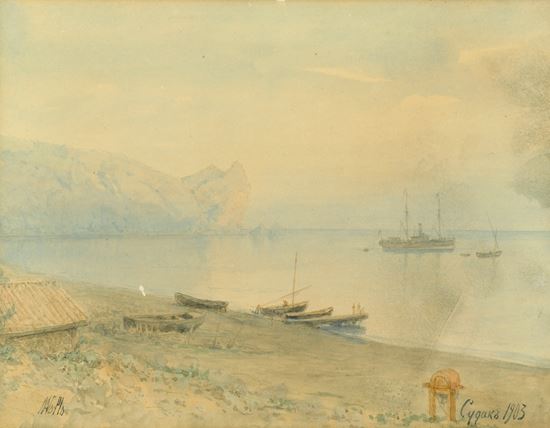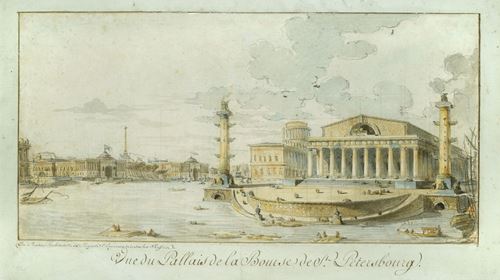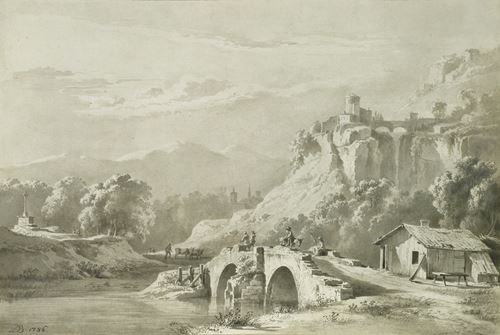ev Felixovich Lagorio
(Feodosija 1827 - St. Petersburg 1905)
Boats by the Shore
signed in Cyrillic (lower left), inscribed in Cyrillic and dated ‘Sudak 1903’ (lower right)
watercolour on paper
23 x 30 cm (9 x 11⅞ in)
In the calm, glassy water of the Bay of Sudak, a steamboat is anchored. A small rowboat departs from its stern and makes its way towards the golden, sandy shore, along which several small boats are moored. The faint outline of three figures can be made out on the jetty, waiting for the boat’s arrival. Sweeping round to the left, the setting sun casts its warm, gentle rays on the promontory. The soft, harmonious palette of Boats by the Shore, and accompanying light effects, hints at the influence of Lev Felixovich Lagorio’s Crimean contemporary, Ivan Konstantinovich Aivazovsky, who was also a regular visitor to Sudak.
Sudak was the location of a house belonging to Lagorio’s father-in-law, in which he had a studio, and the subject of several other works, including Calm on the Sea - Sudak dated to 1885. By the time the present work was executed, Lagorio had long since established himself as a popular marine painter. Executed two years before he died, the present watercolour is representative of Lagorio’s later oeuvre which was typified by an ever increasing depiction of the beautiful northern landscape. During this period, he concentrated on views of the Baltic Sea and Finnish and Norwegian coastlines. As exemplified in the present watercolour, his later works are an expression of considerable romanticism and sensuality, and eloquently express the varied facets of nature.
The historic town of Sudak in Crimea lies on the northern shore of the Black Sea. The city’s history can be traced back to 212 A.D. when it is believed to have been founded by Alani settlers. The Khazars attacked the town in the seventh century and gave it the name of Suğdaq; it is thought to have remained in the hands of the Khazars from the early 800s until 1016, when it was finally taken over by the Byzantines.
Sudak was an important trade town, and over the centuries, due to its strategic location, was coveted by many, including the Venetians, Genoese and Ottomans. In 1783, it passed definitively to the Russian Empire, together with the rest of Crimea. Following the military leader Pavel Potemkin’s (1743-1796) eviction of the Christian population from Crimea in 1778, Sudak’s population quickly dwindled, and by 1805 it had only thirty-three inhabitants.
A painter and watercolourist of landscapes, marines, and battle-pieces, Lagorio was considered to be one of the most fascinating seascape painters of the nineteenth century. Born in the town of Feodosija in 1827, he studied at the Imperial Academy in St. Petersburg under the landscape painters, Maxim Nikiforovich Vorobiov (1787-1855) and Bogdan Pavlovich Villevalde. Like Aivazovsky, Lagorio sailed with the Russian fleet and made sketches of the sea-coasts. In 1845 Lagorio went on a sea voyage on the Groziashchy frigate to study the arrangement of warships. He travelled along the Baltic Sea coast executing studies, and then on to Vyborg and to the Caucasus. He was awarded a gold medal for his View on the Marsh on the Lisy Nos Cape, and in recognition, was granted a trip abroad. Lagorio travelled to Paris and Italy, where he visited Rome, Tivoli, Olevano and Sorrento.
In total, Lagorio spent eight years in Italy, and the work that he completed whilst there brought him much acclaim in Russia; he was ultimately rewarded with a professorship at the Academy. Lagorio painted large canvases on the basis of studies made during his numerous trips to the Caucasus, Black Sea and Caspian coasts. He continued his work by painting the coasts of Finland and Norway and was in demand by the Romanovs to document the wartime years, often being sent to the front to complete pictures glorifying the Russian successes. Lagorio was commissioned to paint a series of battle-pieces for the military gallery of the Winter Palace, depicting the Russo-Turkish war, most of which he executed in the 1880s and 1890s.
In the calm, glassy water of the Bay of Sudak, a steamboat is anchored. A small rowboat departs from its stern and makes its way towards the golden, sandy shore, along which several small boats are moored. The faint outline of three figures can be made out on the jetty, waiting for the boat’s arrival. Sweeping round to the left, the setting sun casts its warm, gentle rays on the promontory. The soft, harmonious palette of Boats by the Shore, and accompanying light effects, hints at the influence of Lev Felixovich Lagorio’s Crimean contemporary, Ivan Konstantinovich Aivazovsky, who was also a regular visitor to Sudak.
Sudak was the location of a house belonging to Lagorio’s father-in-law, in which he had a studio, and the subject of several other works, including Calm on the Sea - Sudak dated to 1885. By the time the present work was executed, Lagorio had long since established himself as a popular marine painter. Executed two years before he died, the present watercolour is representative of Lagorio’s later oeuvre which was typified by an ever increasing depiction of the beautiful northern landscape. During this period, he concentrated on views of the Baltic Sea and Finnish and Norwegian coastlines. As exemplified in the present watercolour, his later works are an expression of considerable romanticism and sensuality, and eloquently express the varied facets of nature.
The historic town of Sudak in Crimea lies on the northern shore of the Black Sea. The city’s history can be traced back to 212 A.D. when it is believed to have been founded by Alani settlers. The Khazars attacked the town in the seventh century and gave it the name of Suğdaq; it is thought to have remained in the hands of the Khazars from the early 800s until 1016, when it was finally taken over by the Byzantines.
Sudak was an important trade town, and over the centuries, due to its strategic location, was coveted by many, including the Venetians, Genoese and Ottomans. In 1783, it passed definitively to the Russian Empire, together with the rest of Crimea. Following the military leader Pavel Potemkin’s (1743-1796) eviction of the Christian population from Crimea in 1778, Sudak’s population quickly dwindled, and by 1805 it had only thirty-three inhabitants.
A painter and watercolourist of landscapes, marines, and battle-pieces, Lagorio was considered to be one of the most fascinating seascape painters of the nineteenth century. Born in the town of Feodosija in 1827, he studied at the Imperial Academy in St. Petersburg under the landscape painters, Maxim Nikiforovich Vorobiov (1787-1855) and Bogdan Pavlovich Villevalde. Like Aivazovsky, Lagorio sailed with the Russian fleet and made sketches of the sea-coasts. In 1845 Lagorio went on a sea voyage on the Groziashchy frigate to study the arrangement of warships. He travelled along the Baltic Sea coast executing studies, and then on to Vyborg and to the Caucasus. He was awarded a gold medal for his View on the Marsh on the Lisy Nos Cape, and in recognition, was granted a trip abroad. Lagorio travelled to Paris and Italy, where he visited Rome, Tivoli, Olevano and Sorrento.
In total, Lagorio spent eight years in Italy, and the work that he completed whilst there brought him much acclaim in Russia; he was ultimately rewarded with a professorship at the Academy. Lagorio painted large canvases on the basis of studies made during his numerous trips to the Caucasus, Black Sea and Caspian coasts. He continued his work by painting the coasts of Finland and Norway and was in demand by the Romanovs to document the wartime years, often being sent to the front to complete pictures glorifying the Russian successes. Lagorio was commissioned to paint a series of battle-pieces for the military gallery of the Winter Palace, depicting the Russo-Turkish war, most of which he executed in the 1880s and 1890s.





 contact
contact +44 20 7313 8040
+44 20 7313 8040









